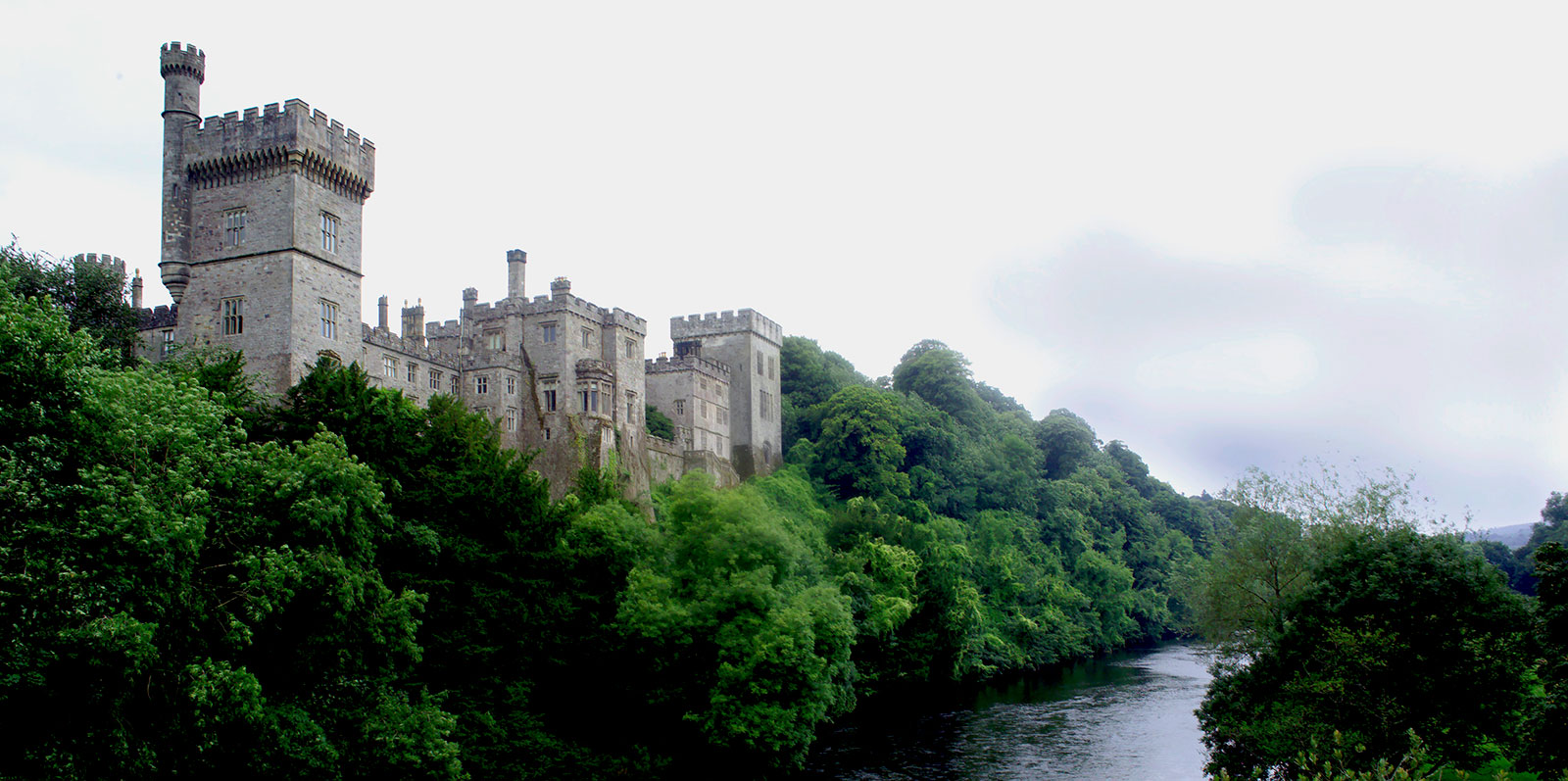Lismore Castle
Guarding a strategic bridge over the River Blackwater and dominating the town, Lismore Castle, in County Waterford, has been occupied continuously since the twelfth century. Prince John's 'castellum' became the palace of the mediaeval bishops. This culminated with its tenure by the turncoat Myler MacGrath, a sort of episcopal Vicar of Bray whose dexterity (at one stage he served concurrently as both a Catholic and a Protestant bishop) was exceeded only by his corruption. He began his ministry as a Franciscan friar, was a bishop for more than fifty years and became the first Protestant Archbishop of Cashel.
As bishop of Waterford and Lismore MacGrath sold the episcopal estates, and the castle, to the Elizabethan courtier and explorer Sir Walter Raleigh, who amassed a 42,000-acre estate on the borders of Waterford and Cork including the towns of Cappoquin, Lismore and Youghal. Raleigh fell from favour under James I and sold his Irish estates to Sir Richard Boyle for £1,500.
Boyle (1566-1643) was the most successful Elizabethan adventurer in Ireland. He arrived in 1588, the year of The Armada, with twenty-seven pounds in his pocket, some good pieces of jewellery, several suits, a sword and a dagger, boundless energy and an astonishing business acumen. When his first wife died childless, royal patronage and an advantageous second marriage increased his political influence. He amassed a considerable fortune and purchased his Munster estates at a discount while Ireland was recovering from the Elizabethan wars.
Thereafter Boyle, or the "Great Earl" of Cork as he became in 1620, concentrated on securing and developing his holdings, building up his fortune and his political career, and eventually became Lord Treasurer of Ireland. His large family (he had 13 surviving children with his second wife, Elizabeth Fenton) was the foundation of a major dynasty. Their descendants include generals and admirals; architects, collectors, inventors, mathematicians, philosophers, physicists, scientists and writers; administrators, landowners, peers, politicians and statesmen.
Cork rebuilt Lismore Castle, connecting the corner towers with gabled residential ranges to form a large and elaborate strong house, with a central courtyard and a fine fortified gatehouse. The principal family apartments were perched precipitously on the edge of a cliff, high above the River Blackwater.
Lismore withstood a siege by the Confederate army in 1642 but it fell to Lord Castlehaven and was sacked after Cork’s death. After the Restoration the second earl restored the castle but it received little use during the eighteenth century and remained largely unaltered. Boyle's great-great-granddaughter Charlotte, wife of the 4th Duke of Devonshire and daughter of the architect Earl of Burlington, inherited Lismore in 1748, and it has been the Devonshire’s Irish home ever since.
In the early years of the nineteenth century the 6th ‘Bachelor Duke’ of Devonshire, son of the beautiful Georgiana, inherited Lismore and decided on major improvements. Initially he employed William Atkinson to restore the river range but, a quarter of a century later, he began a more ambitious programme supervised by Sir Joseph Paxton, the highly innovative architect and engineer who designed the Crystal Palace. Paxton had begun his career as the duke’s gardener and they developed a close working relationship, which developed into a friendship after Paxton received critical acclaim.
Paxton rebuilt the remaining three sides of the courtyard in the Victorian ‘castle’ style, cladding them in imported Derbyshire stone and converting the bishops’ former chapel into a banqueting hall, fitted out by Crace, the London decorator, to a design by Pugin.
The castle is now the home of William Burlington, son of the present duke, who lives at Lismore when in Ireland with his wife and family. Beneath the castle ramparts the seventeenth century gardens have been authentically restored.
Address & Contact
Lismore Castle, Lismore, Waterfordt: +353 58 54288
f: +353 58 54896
w: www.lismorecastlegardens.com
Available as a Film Location
Culture and Education
Museum
Concerts, Plays or Recitals
Accommodation and Short Breaks
Overnight with Dinner
Events
Special family celebrations
Meetings or receptions
Activities
Country Sports
Opening Details
House, Gallery and Gardens Open
March 17, 18, 19, 20, 21, 22, 23, 24, 25, 26, 27, 28, 29, 30 31.
April 1, 2, 3, 4, 5, 6, 7, 8, 9, 10, 11, 12, 13, 14, 15, 16, 17, 18, 19, 20, 21, 22, 23, 24, 25, 26, 27, 28, 29, 30.
May 1, 2, 3, 4, 5, 6, 7, 8, 9, 10, 11, 12, 13, 14, 15, 16, 17, 18, 19, 20, 21, 22, 23, 24, 25, 26, 27, 28, 29, 30, 31.
June 1, 2, 3, 4, 5, 6, 7, 8, 9, 10, 11, 12, 13, 14, 15, 16, 17, 18, 19, 20, 21, 22, 23, 24, 25, 26, 27, 28, 29, 30.
July 1, 2, 3, 4, 5, 6, 7, 8, 9, 10, 11, 12, 13, 14, 15, 16, 17, 18, 19, 20, 21, 22, 23, 24, 25, 26, 27, 28, 29, 30, 31.
August 1, 2, 3, 4, 5, 6, 7, 8, 9, 10, 11, 12, 13, 14, 15, 16, 17, 18, 19, 20, 21, 22, 23, 24, 25, 26, 27, 28, 29, 30, 31.
September 1, 2, 3, 4, 5, 6, 7, 8, 9, 10, 11, 12, 13, 14, 15, 16, 17, 18, 19, 20, 21, 22, 23, 24, 25, 26, 27, 28, 29, 30.
11am to 4.45pm
Last entry 4.00 pm
Events
Don Pasquale Schools Opera Night


